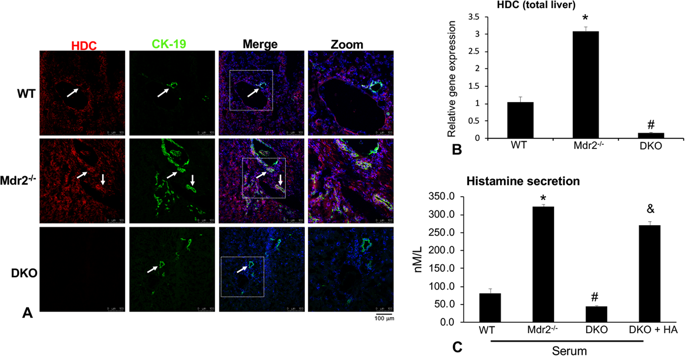当前位置:
X-MOL 学术
›
Lab. Invest.
›
论文详情
Our official English website, www.x-mol.net, welcomes your
feedback! (Note: you will need to create a separate account there.)
Biliary damage and liver fibrosis are ameliorated in a novel mouse model lacking l-histidine decarboxylase/histamine signaling.
Laboratory Investigation ( IF 5.1 ) Pub Date : 2020-02-13 , DOI: 10.1038/s41374-020-0405-8 Lindsey Kennedy 1 , Vik Meadows 1 , Jennifer Demieville 2 , Laura Hargrove 3 , Shohaib Virani 3 , Shannon Glaser 3 , Tianhao Zhou 3 , Evan Rinehart 3 , Victoria Jaeger 3 , Konstantina Kyritsi 1 , Linh Pham 1, 4 , Gianfranco Alpini 1, 2, 3 , Heather Francis 1, 2, 3
Laboratory Investigation ( IF 5.1 ) Pub Date : 2020-02-13 , DOI: 10.1038/s41374-020-0405-8 Lindsey Kennedy 1 , Vik Meadows 1 , Jennifer Demieville 2 , Laura Hargrove 3 , Shohaib Virani 3 , Shannon Glaser 3 , Tianhao Zhou 3 , Evan Rinehart 3 , Victoria Jaeger 3 , Konstantina Kyritsi 1 , Linh Pham 1, 4 , Gianfranco Alpini 1, 2, 3 , Heather Francis 1, 2, 3
Affiliation

|
Primary sclerosing cholangitis (PSC) is characterized by biliary damage and fibrosis. Multidrug resistance-2 gene knockout (Mdr2-/-) mice and PSC patients have increased histamine (HA) levels (synthesized by l-histidine decarboxylase, HDC) and HA receptor (HR) expression. Cholestatic HDC-/- mice display ameliorated biliary damage and hepatic fibrosis. The current study evaluated the effects of knockout of HDC-/- in Mdr2-/- mice (DKO) on biliary damage and hepatic fibrosis. WT, Mdr2-/- mice, and homozygous DKO mice were used. Selected DKO mice were treated with HA. We evaluated liver damage along with HDC expression and HA serum levels. Changes in ductular reaction were evaluated along with liver fibrosis, inflammation and bile acid signaling pathways. The expression of H1HR/PKC-α/TGF-β1 and H2HR/pERK/VEGF-C was determined. In vitro, cholangiocyte lines were treated with HA with/without H1/H2 inhibitors before measuring: H1/H2HR, TGF-β1, and VEGF-C expression. Knockout of HDC ameliorates hepatic damage, ductular reaction, fibrosis, inflammation, bile acid signaling and H1HR/PKC-α/TGF-β1 and H2HR/pERK/VEGF-C signaling. Reactivation of the HDC/HA axis increased these parameters. In vitro, stimulation with HA increased HR expression and PKC-α, TGF-β1, and VEGF-C expression, which was reduced with HR inhibitors. Our data demonstrate the key role for the HDC/HA axis in the management of PSC progression.
中文翻译:

在缺乏 l-组氨酸脱羧酶/组胺信号传导的新型小鼠模型中,胆道损伤和肝纤维化得到改善。
原发性硬化性胆管炎 (PSC) 的特征是胆道损伤和纤维化。多药耐药 2 基因敲除 (Mdr2-/-) 小鼠和 PSC 患者的组胺 (HA) 水平(由 l-组氨酸脱羧酶 HDC 合成)和 HA 受体 (HR) 表达增加。胆汁淤积 HDC-/- 小鼠显示胆道损伤和肝纤维化得到改善。目前的研究评估了 Mdr2-/- 小鼠 (DKO) 中 HDC-/- 敲除对胆道损伤和肝纤维化的影响。使用 WT、Mdr2-/- 小鼠和纯合 DKO 小鼠。用 HA 处理选定的 DKO 小鼠。我们评估了肝损伤以及 HDC 表达和 HA 血清水平。评估了导管反应的变化以及肝纤维化、炎症和胆汁酸信号通路。测定 H1HR/PKC-α/TGF-β1 和 H2HR/pERK/VEGF-C 的表达。体外,在测量 H1/H2HR、TGF-β1 和 VEGF-C 表达之前,用含/不含 H1/H2 抑制剂的 HA 处理胆管细胞系。HDC 的敲除可改善肝损伤、导管反应、纤维化、炎症、胆汁酸信号以及 H1HR/PKC-α/TGF-β1 和 H2HR/pERK/VEGF-C 信号。HDC/HA 轴的重新激活增加了这些参数。在体外,用 HA 刺激会增加 HR 表达和 PKC-α、TGF-β1 和 VEGF-C 表达,而用 HR 抑制剂会降低。我们的数据证明了 HDC/HA 轴在 PSC 进展管理中的关键作用。HDC/HA 轴的重新激活增加了这些参数。在体外,用 HA 刺激会增加 HR 表达和 PKC-α、TGF-β1 和 VEGF-C 表达,而用 HR 抑制剂会降低。我们的数据证明了 HDC/HA 轴在 PSC 进展管理中的关键作用。HDC/HA 轴的重新激活增加了这些参数。在体外,用 HA 刺激会增加 HR 表达和 PKC-α、TGF-β1 和 VEGF-C 表达,而用 HR 抑制剂会降低。我们的数据证明了 HDC/HA 轴在 PSC 进展管理中的关键作用。
更新日期:2020-02-13
中文翻译:

在缺乏 l-组氨酸脱羧酶/组胺信号传导的新型小鼠模型中,胆道损伤和肝纤维化得到改善。
原发性硬化性胆管炎 (PSC) 的特征是胆道损伤和纤维化。多药耐药 2 基因敲除 (Mdr2-/-) 小鼠和 PSC 患者的组胺 (HA) 水平(由 l-组氨酸脱羧酶 HDC 合成)和 HA 受体 (HR) 表达增加。胆汁淤积 HDC-/- 小鼠显示胆道损伤和肝纤维化得到改善。目前的研究评估了 Mdr2-/- 小鼠 (DKO) 中 HDC-/- 敲除对胆道损伤和肝纤维化的影响。使用 WT、Mdr2-/- 小鼠和纯合 DKO 小鼠。用 HA 处理选定的 DKO 小鼠。我们评估了肝损伤以及 HDC 表达和 HA 血清水平。评估了导管反应的变化以及肝纤维化、炎症和胆汁酸信号通路。测定 H1HR/PKC-α/TGF-β1 和 H2HR/pERK/VEGF-C 的表达。体外,在测量 H1/H2HR、TGF-β1 和 VEGF-C 表达之前,用含/不含 H1/H2 抑制剂的 HA 处理胆管细胞系。HDC 的敲除可改善肝损伤、导管反应、纤维化、炎症、胆汁酸信号以及 H1HR/PKC-α/TGF-β1 和 H2HR/pERK/VEGF-C 信号。HDC/HA 轴的重新激活增加了这些参数。在体外,用 HA 刺激会增加 HR 表达和 PKC-α、TGF-β1 和 VEGF-C 表达,而用 HR 抑制剂会降低。我们的数据证明了 HDC/HA 轴在 PSC 进展管理中的关键作用。HDC/HA 轴的重新激活增加了这些参数。在体外,用 HA 刺激会增加 HR 表达和 PKC-α、TGF-β1 和 VEGF-C 表达,而用 HR 抑制剂会降低。我们的数据证明了 HDC/HA 轴在 PSC 进展管理中的关键作用。HDC/HA 轴的重新激活增加了这些参数。在体外,用 HA 刺激会增加 HR 表达和 PKC-α、TGF-β1 和 VEGF-C 表达,而用 HR 抑制剂会降低。我们的数据证明了 HDC/HA 轴在 PSC 进展管理中的关键作用。











































 京公网安备 11010802027423号
京公网安备 11010802027423号